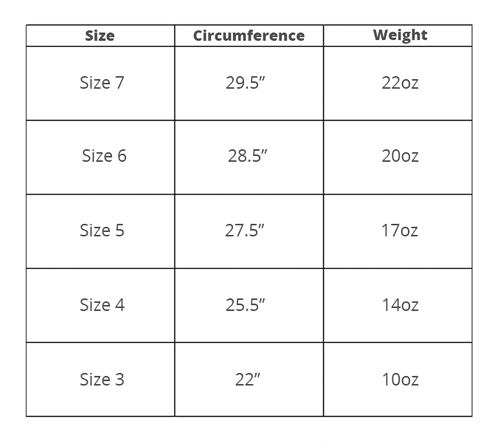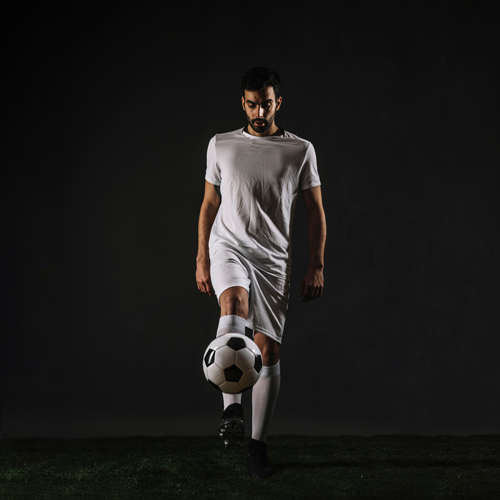Kick Off Right: Choosing Correct Soccer Ball Size for Your Age Group

Table of Contents
ToggleSports are a great way for kids to stay active and learn the value of teamwork. Soccer balls, however, come in many sizes. Knowing which soccer ball size is right for your age group is key to having a successful kick off. Choosing correct soccer ball size is important for getting the most out of your game, whether you’re playing recreationally or competing in a tournament. Read on to learn how to choose the right soccer ball size for different age groups.
Why Size Matters: Understanding the Importance of Choosing Correct Soccer Ball
Soccer is one of the most popular sports in the world and it’s important to choose the right soccer ball size for the best playing experience. It’s not just about kicking around any ball – different age groups require different ball sizes.
Professional Soccer Balls, such as the FIFA Pro Level Match Ball, are used by skilled players at the highest level of the game. But for practice, Promotional Soccer Balls are a better fit. These are typically made for all ages to play soccer ball, meaning that they can be used by children, teens, and adults.
But why does size matter? Using the wrong size soccer ball can affect performance, accuracy, and overall gameplay. It can also lead to injuries, especially for young children who may struggle with handling a ball that is too big or heavy for them.
Beach Soccer Balls and Futsal Sala Balls are two other types of soccer balls that have different sizes and weights, depending on the type of game being played. If you’re unsure which soccer ball size is best for your age group or game type, do some research or ask a professional for guidance.
Ultimately, the right soccer ball size will lead to a more enjoyable experience for players of all ages. Don’t let an improper ball size hinder your skills and love for the game. Choose wisely and kick off right.
The Official Soccer Ball Sizes for Different Age Groups

Soccer is a sport that can be enjoyed by individuals of all ages, but not all soccer balls are created equal. In fact, the size of the soccer ball you use should vary depending on your age and skill level. To help you choose the right soccer ball size, we’ve put together a handy guide to the official sizes for different age groups.
First, let’s start with the basics. The standard size of a practice soccer ball is size 5, which is used by professional players and teams around the world. However, this size is not appropriate for all age groups, as smaller children may have difficulty controlling the ball and practicing their skills with a ball that is too large for them.
For children between the ages of 3-6, a size 3 soccer ball is recommended. This smaller ball size is easier for young children to control and maneuver, helping them to develop their foot-eye coordination and improve their skills.
For kids between the ages of 7-12, a size 4 soccer ball is recommended. This ball size is larger than the size 3 ball, but still small enough for kids to handle and control. It is also lightweight enough to help kids improve their kicking power and accuracy.
For teens and adults over the age of 13, a size 5 soccer ball is recommended. This is the standard size for practice soccer balls and is used by professional players around the world. It is large enough to provide a good workout and challenge for older players, helping them to improve their skills and techniques.
When choosing a soccer ball size, it is also important to consider other factors, such as the material and weight of the ball. High-quality soccer balls are typically made from leather or synthetic materials and are designed to be lightweight and durable. Heavier balls may be harder to control, so it is important to choose a ball that is appropriate for your age and skill level.
How to Choose the Right Soccer Ball Size for Young Children (Ages 3-6)

When it comes to choosing the right soccer ball size for young children, it’s important to consider their age, height, and skill level. The most common soccer ball size for young children is size 3, which is appropriate for kids aged 3-6 years old.
It’s important to note that a size 3 soccer ball is smaller and lighter than the regulation size 5 ball used by older children and adults. This is because young children may struggle to handle a larger, heavier ball and could become frustrated or lose interest in the sport.
When choosing a soccer ball for young children, look for a ball that is lightweight and easy for them to control. A ball with a softer, foam-like texture can also be a good choice for young children who are just starting to learn how to play soccer.
Additionally, consider the child’s height when selecting a soccer ball. A child who is on the taller side may benefit from a slightly larger ball than a child who is shorter.
Overall, the key to choosing the right soccer ball size for young children is to find a ball that is easy for them to handle and control. By selecting the appropriate size and weight for their age and skill level, you can help your child feel confident and excited about playing soccer.
How to Choose the Right Soccer Ball Size for Kids (Ages 7-12)

Choosing the right soccer ball size for kids between the ages of 7-12 can be a little trickier than choosing one for younger children. Kids at this age have varying levels of strength and skill, so finding a ball that they can easily control and handle is important.
The official soccer ball size for kids aged 7-12 is size 4, which has a circumference of 25-26 inches and a weight of approximately 12-13 ounces. This size is perfect for kids who are beginning to play more competitively and need a ball that will help them develop their skills.
When choosing a soccer ball for kids in this age group, you’ll want to consider their individual needs and preferences. Here are some things to keep in mind:
1. Strength and Skill Level:
Kids between the ages of 7-12 have varying levels of strength and skill. If your child is smaller or less physically developed, they may struggle with a ball that’s too heavy. On the other hand, if your child is larger or more skilled, they may need a slightly heavier ball to challenge them.
2. Comfort and Grip:
Make sure your child is comfortable with the grip and texture of the ball you choose. Some balls have a smoother surface, which may be easier to handle for kids who are just starting out. Others have a textured surface that provides better grip, which can be helpful for more advanced players.
Soccer balls come in a variety of materials, including leather, synthetic leather, and PVC. Synthetic leather balls are generally a good choice for kids in this age group as they are durable and can handle a lot of wear and tear.
4. Brand and Price:
Different brands offer different features and benefits, so do your research and find a brand that fits your needs. Keep in mind that higher-priced balls are not always better, and there are plenty of affordable options that are just as good.
In summary, when choosing a soccer ball for kids between the ages of 7-12, it’s important to consider their strength and skill level, comfort and grip, material, and brand and price. With these factors in mind, you can choose a ball that will help your child develop their skills and enjoy playing soccer.
How to Choose the Right Soccer Ball Size for Teens and Adults (Ages 13+)

As teens and adults, soccer players need to play with the appropriate ball size to improve their skills and minimize injury risks. Here’s how to choose the right soccer ball size for your age group:
Firstly, keep in mind that the standard size for a regulation soccer ball is size 5. This is the ball size used in professional games and leagues for players ages 13 and older. Therefore, if you’re a teenager or adult, you should play with a size 5 ball.
However, some variations can affect your choice of soccer ball. For example, if you’re playing on a smaller field or indoor soccer, a size 4 ball might be more appropriate. Additionally, if you have smaller hands or feet, you may feel more comfortable playing with a size 4 ball. So, take those factors into consideration when making your choice.
The best way to ensure you choose the right soccer ball size is to test the ball yourself. Hold it with your hands and feel if it’s comfortable to grip. Kick the ball and see if you can control it properly. Make sure the ball is neither too light nor too heavy, and that it bounces consistently and accurately.
Moreover, the ball’s quality can impact your decision. For example, high-quality soccer balls may be more responsive and durable than low-quality ones, so they may be worth the extra expense.
Lastly, ask for recommendations from experienced players or coaches, who can give you helpful advice based on their own experiences.
Other Factors to Consider When Choosing a Soccer Ball, such as Material and Weight
While choosing the correct soccer ball size is essential for a successful game, there are other important factors to consider when selecting the right ball. Two crucial factors are the material and weight of the soccer ball.
Soccer balls come in various materials, such as leather, synthetic, and rubber. Leather soccer balls are the most durable and of the highest quality. They are used for professional matches but come with a higher price tag. Synthetic balls are affordable and durable, making them a great option for most players. Rubber soccer balls are commonly used for training and recreational play as they are the most affordable and resistant to wear and tear.
The weight of the soccer ball affects the speed and control of the game. A heavier ball travels at a slower pace and is easier to control, making it ideal for beginners. Lighter balls are more challenging to control but can travel faster, making them great for intermediate and advanced players.
Selecting the Right Soccer Ball
Choose a weight that fits your skill level and the purpose of the game. When selecting a soccer ball, consider other important factors, including the bladder, surface type, and inflation level. Soccer balls with latex bladders hold air better, resulting in improved ball control. If you play on grass, opt for a ball with a harder surface, while a softer surface ball is more suitable for turf or indoor play.
ASI Soccer: Quality Balls for Every Player
Additionally, the inflation level is critical, as overinflated or underinflated balls can significantly impact your game’s outcome. ASI Soccer, a sports ball manufacturing company from Sialkot, Pakistan, has been producing top-quality soccer balls for all age groups since 2006. With a commitment to excellence, ASI Soccer provides a diverse range of soccer balls designed to meet the needs of players worldwide.





